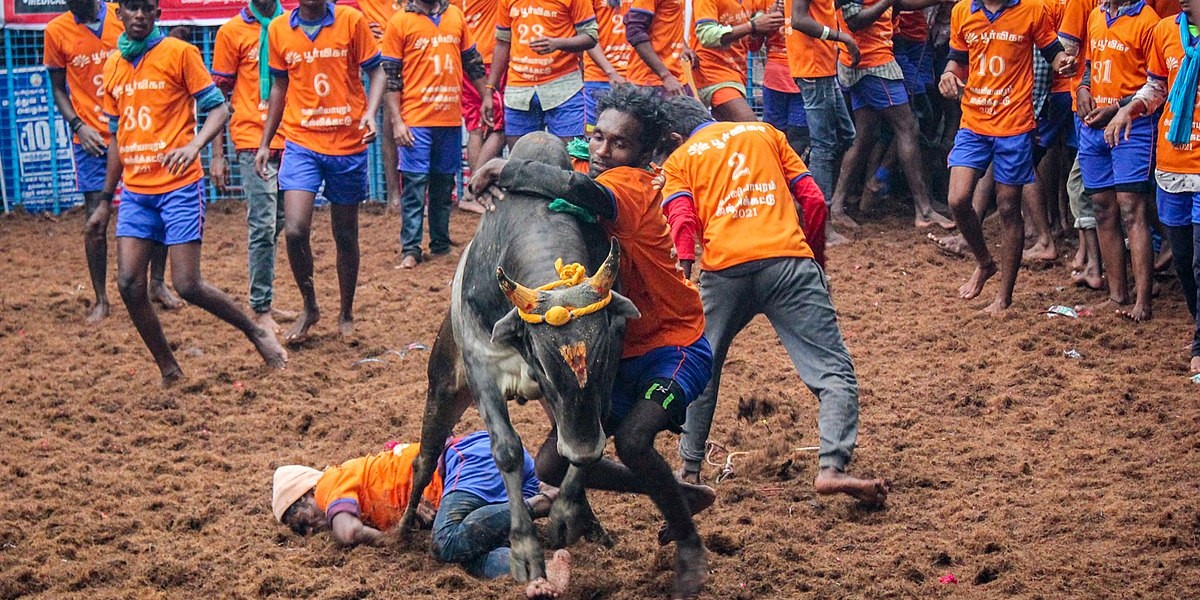Trainers with years of experience are guiding the youth to handle the bulls carefully without sustaining any injuries.

Jallikattu in Madurai of Tamil Nadu. (Creative Commons)
V Gangadharan
Every time the bull was released into the sporting arena, the cow pushed her tail between her hind legs and raised her ears. The milch cow, tethered to a tree, pretty close to the arena was apparently apprehensive and perhaps afraid as the bull repeatedly charged at her.
Veerapandi village near Madurai city was humming, young men training hard to succeed as ace tamers in the bull taming sport Jallikattu, which traditionally commences in the Tamil month of “Thai” (January) and is conducted in several regions of Tamil Nadu.
Under the watchful eyes of master trainers, ‘Mudakkathan’ Mani and ‘Police’ Vinoth, the young men learn the significance of sharp reflexes and the appropriate methods to hold on to a bull’s hump to ensure that there is no injury to man and animal. Workout sessions are now in full swing.
The Vadi, entry point to the makeshift sporting arena in the village, was abuzz with youths and bulls raring to go and little ones huddling on a platform under a large tree to cheer the trainees.
A few men lined up on both sides of the Vadi, ready to make a soft jump onto the animal.
“Lower your left hand a little below the hump and have a watch over your legs too,” Mani shouted at Sriram Marudhupandi, a college student.
The youth, who managed to get to the hump, could not sustain the brief success as the bull eventually gave the youth the slip and he tripped and fell to the ground with a thud.
“Adjusting the position of the hand very fast is important to avoid injury. If the bull turns its neck, its horn may pierce or hit the tamer badly,” Mani, a veteran bull tamer, who has successfully tamed over 3,500 bulls over a span of about 25 years, told PTI.
“The tamer’s legs should not go too close to the animal’s legs. The aspirant’s knees must bend slightly backwards as and when needed.”
When Karthikeyan, a 28-year-old bank employee, inadvertently took a step ahead of the animal, Vinoth screamed, asking him to run beside the bull.
“Careful man, go on the side of the animal, run parallelly, eyes on its hump for a good embrace,” Vinoth, who has tamed 2,000-plus bulls, instructed the youth. He is a regular participant in Jallikattu for the past 20 years. A Grade-I police constable, he trains young men during his leisure.
Mani and Vinoth also act like “bulls” and teach the importance of not touching the horn or tail.
Moments later, another bull is released and the lessons are repeated. “Look at the eyes, in all probability, it will turn left. Men on left alert,” shouted Mani. After a short gallop forward, the bull swerved left!
All the while, two young men attend to the bull. They release it at the Vadi, run behind the bull to get hold of the very long rope attached to it, and bring the animal back to the designated spot.
Now, when tamers are all set for one more round of practice, the bulls majestically jump forward and moments later trainers tell an aspirant to “abort” in a loud voice.
The young man could not embrace the bull perfectly as it leapt aggressively, and others were left behind.
“Here the timing was missed. The embrace should be on time and both hands should go forward around the hump to make a kind of a circle to get the required grip. The whole body of the tamer, right from his head, should be in perfect alignment with that of the animal. The man’s side and animal’s side should be in sync.”
To a question on learning, Mani and Vinoth, both in their late 30s said in unison: “The baby step in learning to tame a bull is to rear it. We give bull calves to aspirants for the purpose of rearing. Slowly, they need to have a love for animals and, of course, perseverance and courage.”
“This is the start of a long-drawn process to develop an emotional connect to the bull and understand its body language, which is fundamental to a harmonious relationship,” they said.
Mani said that holding on to a bull’s hump while it was on the move required knowledge, skill, practice and timing.
“It is all about what to do and at what time and what not to do at all times. Remember, each bull is different when it comes to aggression,” he noted.
Many Jallikattu bulls do not have hooves and the idea is to prevent injuries to men in case the animals kicked them.
Similar training sessions are held in various rural regions of the State. On 8 December 2022, the Supreme Court reserved an order on petitions against the bull-taming game.
The top court had said that Jallikattu cannot be termed a blood sport as nobody is using any weapon and the blood may only be an incidental thing.
Vinoth said that, like humans, animals too understand a given scenario and hone their skills to tackle the situation.
“The cow’s calmness explains that it is sure that the bull is now tethered and away,” Akash, a trainee, chipped in.
As dusk falls, everyone gets ready to call it a day and the cow, freed from the tether, moves on alone, courtesy of its homing instinct.
(Disclaimer: Only the headline, subheads, and intro of this report along with the photos may have been reworked by South First. The rest of the content is from a syndicated feed)

Apr 18, 2024

Apr 18, 2024

Apr 18, 2024

Apr 18, 2024

Apr 17, 2024